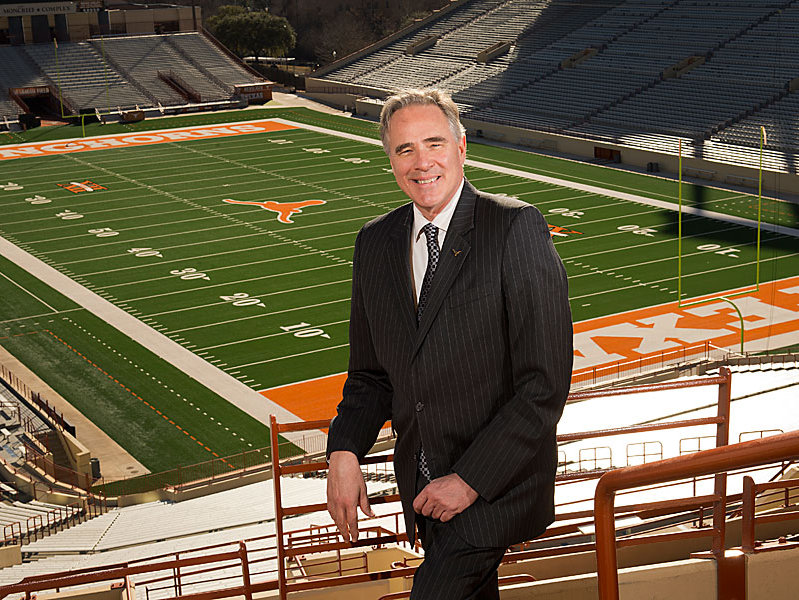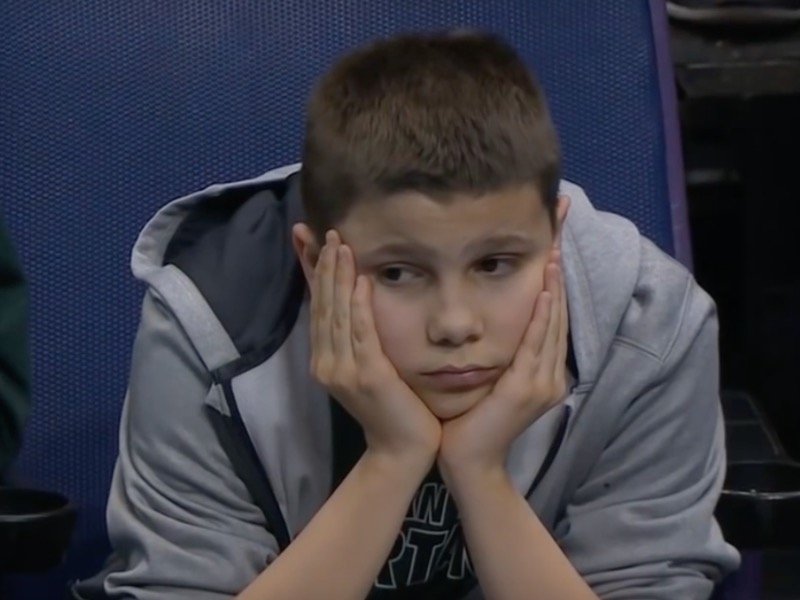Boxes. They’re often where memories are housed. They need to be there, too, because in our temporal lobe they get pushed to the back in favor of recalling a passcode or repeating that you have to get the half and half from the corner stop off.
But when that box is opened, when the dust flies off the packing tape, those little uncatchable particles bursting into your eyes forcing a squint, the real memories surrounding those objects rush to the forefront like they were picked first in a game of schoolyard kickball.
It’s visceral.
It brings you home.
It’s not like Steve Patterson ever forgot his native Beaver Dam or Milwaukee. He spent his formative years there, and has been back often throughout a long career in the National Basketball Association and National Football League.
But when you are now the athletics director at the University of Texas and overseeing one of the largest, most high profile collegiate athletics department in the world, it’s nice to have reminders.
Sometimes, you need to rip open the box and see a late 1960’s t-shirt from a Milwaukee Bucks camp. Or a rendering of an early Bucks logo that featured a long, lion-like tail on a deer.
"I remember he kept that because it was a great laugh," Patterson said of his father, Ray. "Be careful about who you entrust your logo design to."
He laughed.
He could go on and on with this. There was the early Bucks ad campaign to the city of Milwaukee that one of the first draft picks from 1968 "will play his heart out for you this season" – only to know it had to be scrapped when he was one of the first players cut from the team.
Ray Patterson was an integral part of the ownership group that brought the NBA to Milwaukee while also serving as the president and headmaster at Wayland Academy in Beaver Dam. He helped not only found the Bucks, but played an instrumental role in raising the city’s lone championship banner in 1971.
He won the coin flip for the rights to draft Lew Alcindor (now Kareem Abdul-Jabbar) and helped orchestrate the trade for Oscar Robertson.
Interestingly, Ray Patterson divested himself of ownership when the organization struggled to secure a new stadium – an issue still at the forefront of Bucks business today – so he broke south to become the president and general manger of the Houston Rockets.
There, he won back-to-back coin flips to draft Ralph Sampson and Hakeem Olajuwon, results that led to the implementation of the lottery system.
"He was really good at coin flips," Steve Patterson said. "He always said it’s better to be lucky than smart."
He laughed hard at that memory; harder still at the thought that his dad might have won the right to draft Patrick Ewing in the first, non-weighted lottery in 1985 had the young Rockets not made the playoffs.
As the son of an executive with a professional sports franchise, Steve recalls answering sales and ticket calls for the Bucks before there was furniture in the offices, interacting with a host of NBA all-timers, worrying about being picked up for curfew violations after leaving late-finishing games and buying peanuts from a certain vendor on his way into the stadium.
They’re fond memories, and always there – even if they’re not always top of mind. After all, he would spend his adolescence and college years in Texas, and then moved into his own roles in pro sports.
The younger Patterson watched the NBA explode from small time regional entertainment to a global behemoth, and in his tenure in Houston and Portland he helped not only shape rosters, but operate stadiums, secure big events and funding.
He spent some time in the NFL, too, when he helped bring the league back to Houston. In those six years, he helped build a stadium and host a Super Bowl.
It was a long way from the literal mom and pop shop that the Bucks were nearly three decades before.
"It also had more of a ‘homey’ feel," he recalled. "I remember going to an All-Star game. Like at the Cousins’ house in Atlanta – he (Tom) and his brother were the owners of the Hawks and the entirety of the NBA fit in their house. These days you’ve got – the last party I was at was David Stern and 5,000 of his closest friends in a convention center. It’s a little bit different."
For as good as a box of old memorabilia is at rustling up old memories, there’s nothing quite like being back on the actual ground, as Patterson is this weekend.
He arrived Thursday to watch Texas' men’s basketball program compete against his former school in Arizona State University that night at the BMO Harris Bradley Center, a fact he said wouldn’t have been lost on his father.
"When I saw the matchup come up on CBS and where we were playing, I know Ray would have really laughed with my current players against my former players (at Arizona State) in Milwaukee where it all started," he said.
The fact that Patterson has returned to Milwaukee in his current role, an administrator for a university, in the city that now houses the pro franchise his father helped build, is symbolic, too.
He remembers how important education was to his parents, that they – and several of his mom’s siblings – earned college degrees before the GI Bill’s creation in 1944 made it a more attainable dream. That was impressed upon him from an early age growing up in Beaver Dam, where an unsatisfactory book report grade resulted in a second one assigned, and graded, by his father.
After over two decades in pro sports, he joined the college ranks in 2012 when he became the athletics director at Arizona State University, and finds a certain fulfillment in college athletics that just isn’t present in pro sports.
"You really change the arc of a family’s life and that individual’s life," he said. "It’s not just wins and losses. It’s how you represent the university and what are the successful outcomes for the student-athletes that are in your department, whether it be the bowling team, or the tennis team or the cross country (team) or football or basketball."
It isn’t naiveté.
Patterson knows where he’s at, and what his role is.
"We’re in a unique position at Texas where the athletic department is truly an international brand," he said. "I think we’ve got a responsibility to expand globally and I think we’ll have great opportunities to do that and help tell the story of the University of Texas around the country and around the world."
There is a lot on his plate now, and there has been since the moment he returned to his alma mater in this capacity.
Which brings us back to the boxes.
While Patterson has deep ties to Texas – his mom Ruth still lives in suburban Houston – Steve was living and working in Arizona as recently as November. So, forgive him if he’s not completely settled back in just yet. There are boxes to move, to reopen and to remember.
And, though his father passed away in 2011, the elder Patterson held on to a lot of those early Milwaukee Bucks mementos. They’re around too, somewhere, waiting to be revisited.
For now, Steve Patterson is back in Milwaukee, enjoying the city, maybe washing down a Rheinischer Sauerbratenand at Mader's and watching basketball.
"It’s always fun to get back and see how a lot of it has changed and how a lot of it has stayed the same," he said. "It’s great. It’s a great town."
Jim Owczarski is an award-winning sports journalist and comes to Milwaukee by way of the Chicago Sun-Times Media Network.
A three-year Wisconsin resident who has considered Milwaukee a second home for the better part of seven years, he brings to the market experience covering nearly all major and college sports.
To this point in his career, he has been awarded six national Associated Press Sports Editors awards for investigative reporting, feature writing, breaking news and projects. He is also a four-time nominee for the prestigious Peter J. Lisagor Awards for Exemplary Journalism, presented by the Chicago Headline Club, and is a two-time winner for Best Sports Story. He has also won numerous other Illinois Press Association, Illinois Associated Press and Northern Illinois Newspaper Association awards.
Jim's career started in earnest as a North Central College (Naperville, Ill.) senior in 2002 when he received a Richter Fellowship to cover the Chicago White Sox in spring training. He was hired by the Naperville Sun in 2003 and moved on to the Aurora Beacon News in 2007 before joining OnMilwaukee.com.
In that time, he has covered the events, news and personalities that make up the PGA Tour, LPGA Tour, Major League Baseball, the National Football League, the National Hockey League, NCAA football, baseball and men's and women's basketball as well as boxing, mixed martial arts and various U.S. Olympic teams.
Golf aficionados who venture into Illinois have also read Jim in GOLF Chicago Magazine as well as the Chicago District Golfer and Illinois Golfer magazines.







